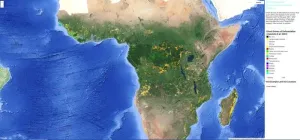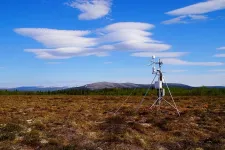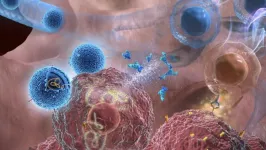(Press-News.org) The natural ends of chromosomes appear alarmingly like broken DNA, much as a snapped spaghetti strand is difficult to distinguish from its intact counterparts. Yet every cell in our bodies must have a way of differentiating between the two because the best way to protect the healthy end of a chromosome also happens to be the worst way to repair damaged DNA.
Consider the enzyme telomerase, which is responsible for maintaining protective telomeres at the natural ends of chromosomes. Were telomerase to seal off a broken strand of DNA with a telomere, it would prevent further repair of that break and delete essential genes. Now, a new study in Science describes how cells avoid such mishaps. These findings show that telomerase can indeed run amok, adding telomeres to damaged DNA, and would do so were it not for the ATR kinase, a key enzyme that responds to DNA damage.
"Telomerase is a good thing because it maintains our telomeres, but it should only be acting at the natural ends of chromosomes. It is very bad if it acts at double-stranded DNA breaks because it can lead to the loss of all genes distal to the break," says Titia de Lange, the Leon Hess professor at Rockefeller. "This detrimental aspect of telomerase is inhibited by the ATR kinase, which, among its many talents, also keeps telomerase away."
The discovery may help optimize CRISPR techniques and could inform the study of cancer.
Enzyme vs enzyme
One of the earliest hints that telomerase could, absent proper controls, act on damaged DNA appeared in 1990, when a study in Nature reported that an individual suffering from α-thalassemia had a broken DNA end with telomeric DNA added to it. But whether telomerase was to blame for this rogue telomere, and how healthy cells prevented this from happening, remained unclear. Charles Kinzig, an MD/PhD student in the de Lange lab, scoured the literature for similar cases and set out to determine whether telomerase was the culprit.
Kinzig and colleagues first broke bits of human DNA with Cas9, the cutting component of the CRISPR gene-editing tool, and established that telomerase creates "neotelomeres" on broken DNA. Having established telomerase as driving the formation of neotelomeres, Kinzig then began interrogating various molecular pathways to determine what prevents telomerase from interfering with DNA repair under normal circumstances. He ultimately found that disrupting ATR kinase signaling increases neotelomere formation and demonstrated that when ATR is activated at DNA breaks, it prevents telomerase from ruining the repair.
"It's a race between telomerase and ATR," Kinzig says. "Telomerase needs the DNA end to be chewed in to form its single-stranded substrate. But at the same time, the single-stranded DNA is what activates ATR.”
From CRISPR to cancer
The findings have immediate implications for researchers and clinicians involved in CRISPR gene editing. Kinzig and colleagues found that telomerase can add telomeric DNA to the DNA ends made during CRISPR editing. This could potentially lead to insertion of telomeric DNA or formation of a telomere at the site where CRISPR editing was intended. “The CRISPR field now is aware of this and can take steps to prevent this unwanted outcome,” de Lange said.
In the long term, the lab plans to focus on how the findings relate to cancer. Telomerase is activated in most human cancers, and it is thought that this helps cancers maintain their telomeres, effectively becoming immortal. Kinzig and de Lange speculate that neotelomere formation may allow cancers to tolerate processes that generate broken chromosomes, such as deficiencies in BRCA1. “We are now testing whether neotelomere formation indeed helps cells deal with the genome instability that plagues cancer cells,” said de Lange. “We’ll see. Much remains to be learned.”
Kinzig, in the meantime, is finishing his medical training and preparing for the next step. “His thesis research was a tour de force,” said de Lange, “in part because he ventured into an area my lab had never worked on.”
END
Keeping telomerase in check
2024-02-15
ELSE PRESS RELEASES FROM THIS DATE:
Competition for food drives the planet’s remaining mass migration of herbivores
2024-02-15
Upending the prevailing theory of how and why multi-species mass-migration patterns occur in Serengeti National Park, researchers from Wake Forest University have confirmed that the millions-strong wildebeest population pushes zebra herds along in competition for the most nutrient-dense grasses.
The study resulting from this research, “Interplay of competition and facilitation in grazing succession by migrant Serengeti herbivores,” appears today in the peer-reviewed journal Science.
For decades, biologists have believed the major grazing ...
UT Dallas Wind Energy Center to expand with new headquarters, resources
2024-02-15
The University of Texas at Dallas’ wind energy research programs have expanded rapidly in recent years, with labs, offices and facilities spread out on campus. In 2020 UT Dallas formed the Wind Energy Center, called UTD Wind, to bring its wind energy programs under one virtual umbrella.
Now, a new initiative will give UTD Wind a physical headquarters for the first time with additional labs, meeting areas and office space. The project also includes additional equipment for wind energy research and education.
UT Dallas has received $1.6 million through the federal Consolidated Appropriations Act to support the expansion, which will bring most of the center’s ...
More Aston University scholarships to encourage graduates from under-represented groups to work in artificial intelligence
2024-02-15
• Eleven scholarships worth £10k each for MSc Applied AI
• They are funded by the Office for Students (OfS)
• Aimed at graduates without a science, tech, engineering or maths degree.
Aston University is offering more opportunities to graduates who want a career in artificial intelligence (AI) but don’t have a science, technology, engineering or maths degree.
The scholarships are offered due to increased funding from the Office for Students (OfS). Each award is worth £10,000 and will be awarded to students enrolling ...
How is deforested land in Africa used?
2024-02-15
Africa's forested areas – an estimated 14 % of the global forest area – are continuing to decline at an increasing rate – mostly because of human activities to convert forest land for economic purposes. As natural forests are important CO2 and biodiversity reservoirs, this development has a significant impact on climate change and effects the integrity of nature. To intervene in a targeted manner in the interests of climate protection and biodiversity, there has been a lack of sufficiently good data and detailed knowledge ...
Studies with more diverse teams of authors get more citations
2024-02-15
Diverse research is more impactful in the business management field, with female influence growing stronger in the past decade, finds a new study from the University of Surrey.
The study analysed all articles published in the last 10 years (January 2012 to December 2022) in the influential Journal of Management Studies.
The empirical analysis examined three key aspects of teams’ diversity:
Internationality (how international is mix of authors),
Interdisciplinarity (how many different fields of study they come from),
Gender ...
UC Irvine researcher co-authors ‘scientists’ warning’ on climate and technology
2024-02-15
Irvine, Calif., Feb. 15, 2024 – Throughout human history, technologies have been used to make peoples’ lives richer and more comfortable, but they have also contributed to a global crisis threatening Earth’s climate, ecosystems and even our own survival. Researchers at the University of California, Irvine, the University of Kansas and Oregon State University have suggested that industrial civilization’s best way forward may entail embracing further technological advancements but doing so with greater awareness of their potential drawbacks.
In a paper titled “Scientists’ Warning on Technology,” published recently in the Journal of Cleaner ...
Methane emissions from wetlands increase significantly over high latitudes
2024-02-15
– By Julie Bobyock
Wetlands are Earth’s largest natural source of methane, a potent greenhouse gas that is about 30 times more powerful than carbon dioxide at warming the atmosphere. A research team from the Department of Energy’s Lawrence Berkeley National Laboratory (Berkeley Lab) analyzed wetland methane emissions data across the entire Boreal-Arctic region and found that these emissions have increased approximately nine percent since 2002.
Livestock and fossil fuel production are well studied for their role in releasing tons of methane per year into the atmosphere. Although more uncertain, quantifying natural wetlands emissions is important to predicting climate ...
Study finds new inhalable therapy is a big step forward in lung cancer research
2024-02-15
Lung cancer is one of the most common cancers and has one of the lowest survival rates in the world. Cytokines, which are small signaling proteins, such as interleukin-12 (IL-12), have demonstrated considerable potential as robust tumor suppressors. However, their applications are limited due to a multitude of severe side effects.
In a paper published Jan. 11 by Nature Nanotechnology, Biomedical Engineering Professor Ke Cheng and his research group demonstrate that using nanobubbles, ...
Damon Runyon Cancer Research Foundation awards $3.2 million to innovative early-career scientists
2024-02-15
The Damon Runyon Cancer Research Foundation has announced eight recipients of the 2024 Damon Runyon-Rachleff Innovation Award, established to support “high-risk, high-reward” ideas with the potential to significantly impact the prevention, diagnosis, or treatment of cancer. Five extraordinary early-career researchers will receive initial grants of $400,000 over two years, and each will have the opportunity to receive two additional years of funding (for a potential total of $800,000). This year, this “Stage 2” continuation ...
Scientific report reveals livestock as the key factor in cheatgrass spread
2024-02-15
For Immediate Release
Contact: Erik Molvar, Western Watersheds Project, 307-399-7910
Roger Rosentreter, Bureau of Land Management, Botanist (Retired), 208-991-8815
Don Mansfield, Emeritus Professor of Biology, College of Idaho, 208-871-8170
Scientific Report Reveals Livestock Grazing as the Key Factor in Cheatgrass Spread
HAILEY, Ida. (February 15, 2024) – A scientific report released today illuminates the causes of cheatgrass spread and compares the effectiveness ...




